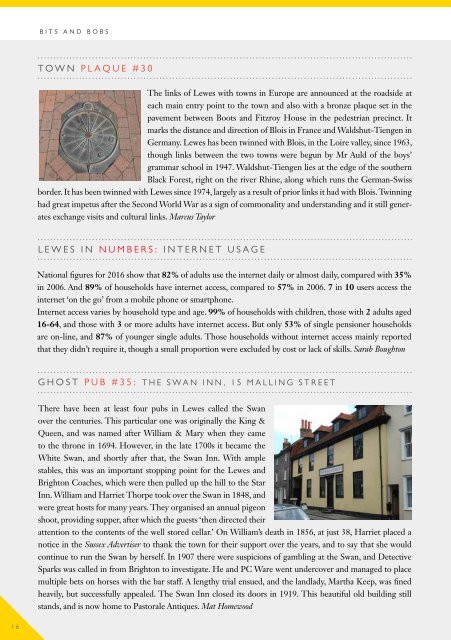You also want an ePaper? Increase the reach of your titles
YUMPU automatically turns print PDFs into web optimized ePapers that Google loves.
BITS AND BOBS<br />
TOWN PLAQUE #30<br />
The links of <strong>Lewes</strong> with towns in Europe are announced at the roadside at<br />
each main entry point to the town and also with a bronze plaque set in the<br />
pavement between Boots and Fitzroy House in the pedestrian precinct. It<br />
marks the distance and direction of Blois in France and Waldshut-Tiengen in<br />
Germany. <strong>Lewes</strong> has been twinned with Blois, in the Loire valley, since 1963,<br />
though links between the two towns were begun by Mr Auld of the boys’<br />
grammar school in 1947. Waldshut-Tiengen lies at the edge of the southern<br />
Black Forest, right on the river Rhine, along which runs the German-Swiss<br />
border. It has been twinned with <strong>Lewes</strong> since 1974, largely as a result of prior links it had with Blois. Twinning<br />
had great impetus after the Second World War as a sign of commonality and understanding and it still generates<br />
exchange visits and cultural links. Marcus Taylor<br />
LEWES IN NUMBERS: INTERNET USAGE<br />
National figures for 2016 show that 82% of adults use the internet daily or almost daily, compared with 35%<br />
in 2006. And 89% of households have internet access, compared to 57% in 2006. 7 in 10 users access the<br />
internet ‘on the go’ from a mobile phone or smartphone.<br />
Internet access varies by household type and age. 99% of households with children, those with 2 adults aged<br />
16-64, and those with 3 or more adults have internet access. But only 53% of single pensioner households<br />
are on-line, and 87% of younger single adults. Those households without internet access mainly reported<br />
that they didn’t require it, though a small proportion were excluded by cost or lack of skills. Sarah Boughton<br />
GHOST PUB #35: THE SWAN INN, 15 MALLING STREET<br />
There have been at least four pubs in <strong>Lewes</strong> called the Swan<br />
over the centuries. This particular one was originally the King &<br />
Queen, and was named after William & Mary when they came<br />
to the throne in 1694. However, in the late 1700s it became the<br />
White Swan, and shortly after that, the Swan Inn. With ample<br />
stables, this was an important stopping point for the <strong>Lewes</strong> and<br />
Brighton Coaches, which were then pulled up the hill to the Star<br />
Inn. William and Harriet Thorpe took over the Swan in 1848, and<br />
were great hosts for many years. They organised an annual pigeon<br />
shoot, providing supper, after which the guests ‘then directed their<br />
attention to the contents of the well stored cellar.’ On William’s death in 1856, at just 38, Harriet placed a<br />
notice in the Sussex Advertiser to thank the town for their support over the years, and to say that she would<br />
continue to run the Swan by herself. In 1907 there were suspicions of gambling at the Swan, and Detective<br />
Sparks was called in from Brighton to investigate. He and PC Ware went undercover and managed to place<br />
multiple bets on horses with the bar staff. A lengthy trial ensued, and the landlady, Martha Keep, was fined<br />
heavily, but successfully appealed. The Swan Inn closed its doors in 1919. This beautiful old building still<br />
stands, and is now home to Pastorale Antiques. Mat Homewood<br />
16


















